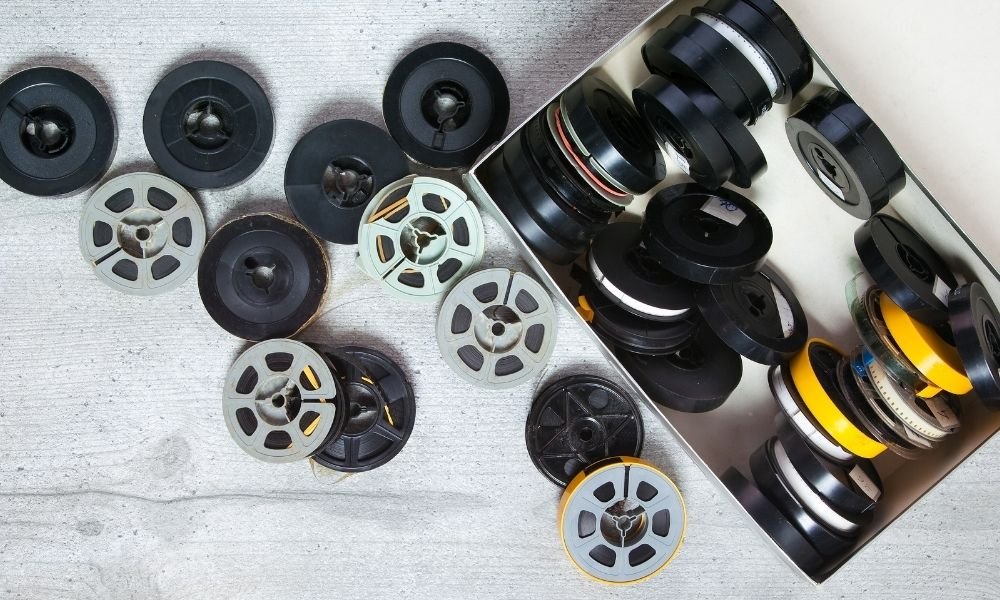A Complete Guide to the Film Types and Formats
Since their invention in the 19th century, moving pictures and films have captivated audiences. Surprisingly, film types and formats haven’t changed much since their creation! In our complete guide to the film types and formats, we’ll go over the basics of the most common film types and their fascinating histories from the 1890s to modern times!
Basic Makeup of Film Types
Before we get started on breaking down the different types of films and their formats, we’ll explain the basic makeup of films that differentiates them:
Width of film
Frame size
Sprocket holes (size and location)
Soundtrack
Width of Film
The main distinction between film types is width. You’ve no doubt heard of 8mm and 16mm films before, and those sizes refer to the width of the film.
Why does the width matter? In general, the wider the film, the better the resolution. Although, today, that’s not always the case with technological advancements, as some filmmakers prefer 16mm over 35mm. You can look up a 16mm film versus a 35mm film online and see the difference in resolution quality.
Frame Size
A film’s frame size refers to the picture-taking area—literally the little square picture you see in a reel of film. Different films have different sizes and aspect ratios.
For example, 8mm and Super 8 film have the same width, but they have different frame sizes, which makes a huge difference. 8mm film has a frame size of 4.5mm x 3.3mm, while Super 8 is more prominent at 5.8mm x 4.01mm.
Sprocket Holes
Have you ever looked at a film reel and seen tiny holes along the sides? Those are film perforations, or sprocket holes. These are placed in the stock during manufacturing and transporting and steady the film with sprockets or claws.
Some films, like 8mm, Super 8, and 16mm, have sprocket holes in only one size. Standard 35mm film has sprocket holes on both sides, as does some 16mm film.
Fun Fact: The sprocket holes of Super 8 film are smaller than the standard 8mm due to their larger frame size.
Soundtracks
Finally, we have soundtracks. All the films we’ve mentioned so far (8mm, Super 8, 16mm, 35mm) can record sound, although not every film was capable upon release and required separate audio equipment.
For 8mm and Super 8 film, you can see the soundtrack as a rust-colored stripe down one edge. 16mm and 35mm soundtracks are more advanced and can manifest in the film in various ways.
Film Sizes and History
Now that we’ve got the basics of film down, it’s time to go into the specifics of the most famous film formats and their history, from the standard 35mm to the Super 8!
8mm
The 8mm film came along in 1932 from Kodak. This brand wanted to give users a more affordable and easier-to-use format alternative to the 16mm. It was also a response to the European 9.5mm film, invented by the Pathé company.
Despite its name, 8mm film is not half the size of 16mm—it’s a quarter of the size of 16mm, making it less cumbersome and less expensive. It worked with the Kodak “double 8” system, which used a 16mm spool with 8mm sides. The operator would turn over and rethread the film after the first half was exposed.
8mm film was popular for years but fell out of favor with the invention of the Super 8 in the 1960s. Today, you can still transfer the film to digital with an 8mm film to digital conversion service that preserves the film longer and allows for easier access.
Super 8
Even if you’ve never seen a film reel or used a film camera, you’ve probably heard of Super 8. Kodak introduced the new film in 1965 as an improvement of the dominant 8mm to make it more affordable and even more accessible for amateur filmmakers to use.
Super 8 film didn’t require threading of the reel like 8mm, and came with filters and lighting improvements for better picture quality. Filmmakers no longer needed different film stocks due to the lighting.
Initially, Super 8 required separate audio equipment for soundtracks. In 1973, Kodak introduced Super 8 film with a magnetic strip on the side for recording sound, making it even more popular with home filmmakers.
16mm
Second only to the standard 35mm in its age and breadth of use, 16mm has been around since 1923, when it was invented as a more affordable alternative to 35mm. 16mm was also safer than 35mm because its chemical makeup was less flammable than the notorious 35 mm cellulose nitrate.
Fun Fact: The 16mm film’s chemical makeup gave it the nickname “safety film.”
Filmmakers also liked that the 16mm did not produce negatives, only positive camera originals. Since it didn’t make negatives, filmmakers saved time and didn’t have to go through the lengthy process of developing film.
Although it was initially considered cheap and sub-standard to 35mm, 16mm technology developed to where 16mm film is of a similar quality today to 35mm film. Recent award-winning films such as Carol (2015), The Hurt Locker (2008), and Fruitvale Station (2013) were all shot on 16mm film.
35mm
Finally, we come to the benchmark of the film industry: 35mm. Invented in 1889 by William Kennedy Dickson, 35mm film quickly became the standard thanks to its development and distribution by Eastman Kodak and Thomas Edison’s film company.
35mm film was the basic technology of the industry until the 1950s, when more technologies and film types became available. However, it was still the dominant film format until the past decade, when digital film started to supplant it.
35mm film can host four different types of soundtracks:
Analog optical recording
Sony Dynamic Digital Sound (SDDS)
Dolby Digital Sound
DTS time code
The original soundtrack type was analog optical, which recorded sound as waveforms containing audio signals for the left and right audio channels. If you look at 35mm film with analog optical recording, you’ll see two white lines to the right of the sprocket holes. That’s the audio!
In the 1990s, SDDS, Dolby Digital Sound, and DTS time code came to prominence with advanced audio recording technology. Nowadays, almost all 35mm films include all four soundtracks—allowing for broad distribution so practically any cinema worldwide can show it.
Other Film Sizes
We’ve talked at length about 8mm, Super 8, 16mm, and 35mm, but there’s still so much more! Throughout the history of film, various film types and formats worldwide have come and gone. These film types include:
9.5mm
17.5mm
22mm
28mm
These film formats have mostly disappeared from the industry, but historians and film buffs still work to collect and preserve these films for historical purposes.
We hope you’ve enjoyed our complete guide to the film types and formats! The history of film is expansive and fascinating, and if you have any more questions about film or film conversion, consult with the experts at DiJiFi! And, DiJiFi can transfer all of the film mentioned above into digital files, including 9.5mm, 17.5mm, 22mm and 28mm film.


